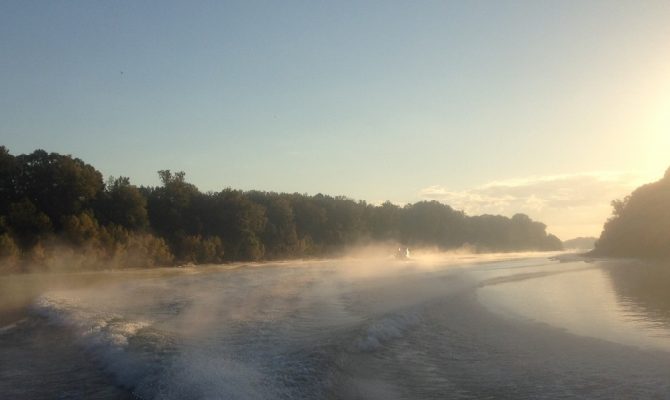Eds. Note: You can read Part 1 of this story at https://quimbyscruisingguide.com/special-delivery-from-lake-of-the-ozarks-to-florida-part-1/.
I’m a firm believer in the idea that the most dangerous thing on a boat is a schedule. A schedule makes you go faster than you should, leave when it would be better to stay put, and push later and farther than you would have otherwise.
But that’s the nature of being a delivering captain. We’re hired to get a boat someplace, on time, at a cost agreeable to the owner. All of which dictates a schedule.
It’s rainy, cold and still dark out? Doesn’t matter. It’s time to go. Breakfast on the run, lunch with a line in your hand and dinner after sundown when the boat is clean and plans are made for early the next day. Yep, that’s us.
That’s where we pick up our voyage, which started in Lake of the Ozarks, Mo., and continues now from Grand Rivers, Ky.
Day 5
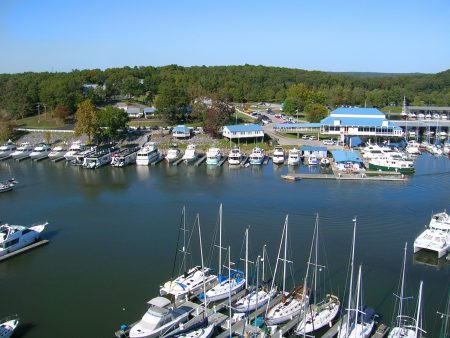
Green Turtle Bay Resort & Marina
We departed Green Turtle Bay Resort & Marina at 6:35 a.m., made our way to the canal and crossed into Kentucky Lake. I was running the boat at a comfortable 11 knots and burning around 18 gph of fuel. After an hour, the owner sat down next to me and asked, matter of fact, “Is there a reason why we’re doing 11 knots?” Thinking I was going too fast, I started to pull back the mains. He said, “No, I mean, this boat will cruise at 30 knots. Why are we only going 11?” I started talking range and fuel costs, and was met with a curled eyebrow. “I don’t give a crap about that. I pay you guys by the day. Let’s roll.”
We were in the open lake, so I let the mains run up to 28 knots and watched the fuel burn climb over 80 gph. I know some marinas with fuel pumps that don’t pump 80 gph (although I try to avoid them). The owner wasn’t flinching at the burn rate, so on we went.
We arrived at Pickwick Lock at 3:30 p.m. and had a short, 30-minute wait to lock through. We stopped a couple hours later at Grand Harbor Marina at the top of the Tenn-Tom Waterway. It had been a big day of travel, covering 195 statute miles, or approximately 170 nautical miles, and we were beat.
We talked with the dockmaster, who said to give Freddy T’s restaurant a call. They would send a driver to pick us up. Freddy T’s is an oasis in the middle of nothing on the border of Tennessee and Mississippi. The closest major city is Memphis, over 115 miles away. It had he normal burgers, fries and sandwiches, but the steaks were grilled perfectly and the wine cellar was huge. Still, it’s amazing that it survives over the winter.
Day 6
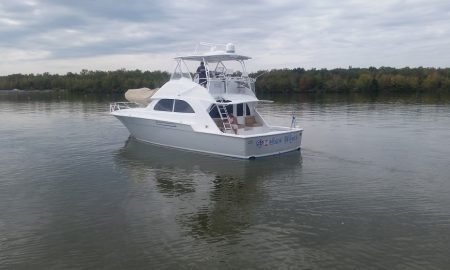
Our Bertram running mate
It’s unusual for another boat to beat us out of the marina in the morning, but the Bertram we’d been keeping time with did by 30 minutes. We were going to hang around for the fuel dock to open, but after some quick calculations, we decided we’d be fine to wait until that evening. At 7:15 a.m., we pulled the lines and headed down the Tenn-Tom.
We had seven locks to do to make Columbus, Miss. It was going to be a busy day. The first was Whitten Lock. At 84 feet, it has the largest lift (drop in our case) of any lock on the Great Loop and is the fourth largest lift in the U.S. It literally moves you over the western Smokey Mountains, out of the Tennessee River Valley and into Tombigbee River.
Locks are the great speed equalizer on the Tenn-Tom, and we’d now caught up with the Bertram as it waited for the lock to turn around.
There are over 75 defined “no-wake” areas on the Tenn-Tom in the 230-odd miles between Lake Pickwick and Demopolis, Ala. These are areas with docks, boat ramps or marinas. Anywhere around these you’re likely to encounter small fishing vessels along the shore, so a keen lookout is necessary to make sure you don’t hurt someone or cause damage.
It would be great if fisherman wore bright orange coats rather than camouflage. It’s darn difficult to see some of these guys until you’re almost on them, and I really don’t think the fish care what they’re wearing. We do our best, not only because it’s the right thing to do but because Bubba the Bass Fisherman’s uncle is probably the lockmaster at the next lock or his brother-in-law the sheriff.
It was a day of speed-up, slow-down. We were following the Bertram and matching his speed a mile back. He found most of the fisherman. The ones he didn’t find found us and, regardless of our speed, waived a funny one-finger salute.
A good thing with the Tenn-Tom is there is very little commercial traffic in the upper section. If you keep up good communications with the locks, act professionally and maybe even give a few soda’s out along the way, you’ll be sequenced right through.
We were having a good day, and by 3:15 p.m., we cleared the Whitten, Montgomery, Rankin, Fulton, Wilkons and Amory locks. We made a call to Columbus and asked if they’d wait for us to fuel tonight, as we knew it would be after 5:00 p.m. and we had another lock to clear. We didn’t fail to mention that we were taking on 800 gallons of fuel, at which point they became more enthusiastic about waiting.
We arrived at 5:15 p.m. at Columbus Marina. We’d traveled 120 statue miles (104 nautical miles). As promised, we took on a little under 800 gallons of fuel. Due to our lateness, we missed the famous Looper’s barbecue. The marina had a courtesy car available, so we took the opportunity to reserve it for dinner.
Before leaving, we talked with a few of Loopers. They had a lock scheduled for 7:00 a.m. just below Columbus Marina. Everyone was going to coordinate on VHF and queue up for the lock.
Something we delivery captains often miss out on is the camaraderie that builds among a group of boats traveling together. We meet some good people in our travels but usually only see them for a day, a day and night at best. Then, we’re way ahead of them and catching up with the next group.
We’d traveled for the entire day with the Bertram. We learned he had his parents on board, both over 80 years old, and was traveling to Florida to keep his boat in the Keys for the winter. He and his parents joined us for the trip into town for dinner.
Over food and drinks, we discussed the next day. Our plans were to make Demopolis Yacht Basin and Kingfisher Bay Marina. The Bertram had the same plans.
Day 7
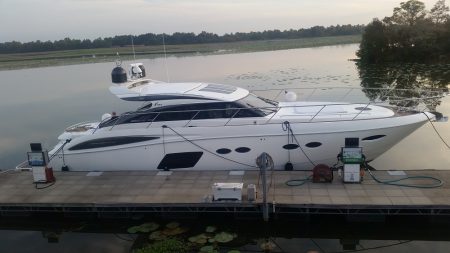
The Princess V62 at the dock
It had been a week on the water now, and life had fallen into a daily routine. Wake up at 5:00 a.m., make coffee and check the weather. Next, get into the engine room to do the morning inspection. A 30-point checklist is completed, which includes all fluid levels, shaft logs, rudder posts, safety equipment and overall condition. If we find anything unusual compared to previous checks, we record, monitor, notify and perhaps repair what we find. Even new boats will develop issues, and catching them early is the difference between an inconvenience or a high-cost repair.
So far, we’d discovered a number of minor issues: 1) We were leaking 4 to 5 gallons a day of freshwater from the tank; 2) a shower sump was clogged and not pumping; and 3) we had a slight hydraulic leak in the steering (one to two drops per day). We noted the problems, communicated them with the owner and logged them for warranty repair.
We were on the VHF at 6:15 a.m., waiting for a roll call of boats leaving the lock. We knew we’d want to be ahead of the pack, so we pulled our lines early and proceeded out to the channel to wait. Ten boats were going to lock down, and the lock wasn’t going to open until all were present and accounted for.
It was 8:00 before everyone had their act together. I guess that’s the bad thing about traveling with a pack if you’re trying to make time.
We cleared the Stennis Lock at 8:50, and the Bertram insisted we take the lead. We were back on the binoculars, scanning the shore for camouflaged fisherman and running as quick as we dared. It was a clear, pretty day. There was a little surface fog — not enough to restrict visibility but enough to add to the beauty of the morning.
We had two more locks to clear: Bevill and Howell. Another day of stop-and-go, slowing for no-wake zones and whenever we saw a fishing boat or other small craft. The area between Heflin and Demopolis is fairly notorious for irate fisherman.
Going at bare steerage, we had a bass boat buzz past us, turn around and do zig zags heading right at us. Chip said, “I think that’s a gun in his hand!” We all hunkered down and hoped he didn’t shoot. We’re not sure what we did to annoy him, but Chuck in the Bertam said he’d done the same to him. Perhaps it was a case of “small boat syndrome.”
We arrived at Demopolis at 4:30 p.m., fueled the boat and proceeded to our slip assignment at Kingfisher. Demopolis is a must-stop for fuel, since, if not staying on the hook, you either have to make it all the way to Mobile (235 statute miles) or stop at Bobby’s Fish Camp (109 statute miles).
Day 8
We talked with the lockmaster starting at 5:30 a.m. and were rolling early out of Demopolis. The sun was just rising as we entered the lock below the yacht basin. We again where traveling with the Bertram in the lead. Our plan was to see what time we got to Coffeeville Lock. If we could get right through and it looked like we’d have daylight in Mobile, we’d keep going. Otherwise, we’d pull into Bobby’s for the night.
I like Bobby’s Fish Camp. Everyone should really stop there once and experience it. No one would ever call it luxurious. It’s a dock on the river with fuel and sketchy electric. There’s a restaurant with a lot of fried food and great catfish. It’s $1.50/foot for not a lot, but a refuge in any storm.
The river was wide open, with very few fishermen. By 12:50, we’d put 100 miles under our keel and were having a conversation with Coffeeville Lock. They turned the lock around for us, and by 1:20, we were on our way to Mobile. We had 125 miles to go and about six hours of daylight. We would be getting to Mobile after dark, but it felt good to be free of the locks and on our way to the blue water.
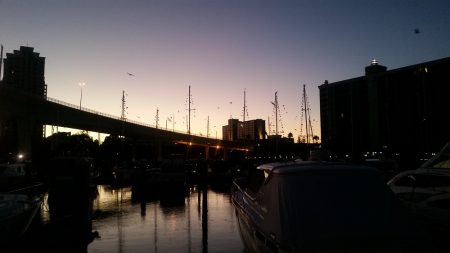
Mobile, Alabama
The place to stop in Mobile is Dog River. You have three choices: Dog River Marina, Turner Marine or the Grand Mariner. I’d stayed at the first two but never the last. Our yacht’s owner wanted to eat at a restaurant, and given the time of our arrival, I recommended we stay at Grand Mariner since it was the only one with an onsite restaurant and I’d always wanted to check it out.
It was a Saturday night in the bayous of ’Bama, and the Grand Mariner was in full swing. We were met by at least 10 people, most with either a beer or bottle of whiskey in their hand. They caught lines really well but tied lines about as good as moths sew. We thanked them for their help and got to work redoing all our ties.
After numerous adjustments, we were finally secure. We’d covered 15 hours on the run for 235 miles.
Day 9
We didn’t really need fuel, but the price was good and it was going to be an easy day over to Pensacola. We began pumping fuel at 9:00 a.m. By 9:30, we’d taken on a whopping 50 gallons. By 10:00, we’d just hit 100 gallons and decided we’d better finish fueling in Florida.
The Bertram fared no better. They saw our dilemma and putted across the channel to Dog River Marina. Its pump hadn’t been turned on yet, and when they did, it wasn’t working. They waited for it to be repaired while we watched fuel enter our boat slower than we burned it on a number of our runs.
We finally pulled out at 10:20 and made our way down Mobile Bay to the Intracoastal Waterway (ICW). We arrived at Perdido Key, just before Pensacola, at 1:50 p.m., where we stopped for the day to set up for crossing to Clearwater. We were right on the Florida-Alabama line.
The owner had a friend arriving the following day to do the final leg of the trip with us. So, we had almost 24 hours to chill. We spent the day giving the boat a good cleaning, checking all the systems and resting for the overnight the next day.
Day 10
The Bertram pulled out early in the day. It would not be making the crossing with us due to its more limited range. It was going to cruise to Carrabelle that day and make the run down to Clearwater the next and try to catch up with us.
The owner’s friend arrived about noon. We left Pensacola mid-afternoon, and as we proceeded down the ICW, a pod of dolphins rode our bow wave — a good sign! Our plan was to divide the cruise into four-hour watches with two people on each watch. Chip and I started. We’d take it until dark and let the owner and his friend take the second watch until midnight, then we’d take the graveyard shift until sunrise.
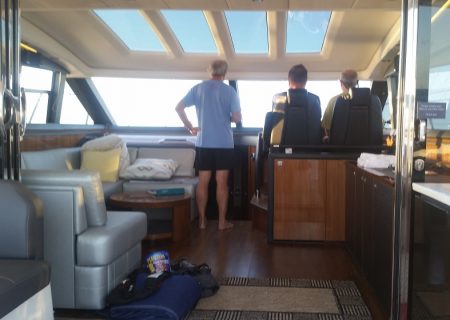
Making the crossing
It’s 5 o’clock somewhere, and it became 5 o’clock on our boat sooner than expected. As Chip and I navigated, we noted the owner and his buddy had become a little more jovial. Sure enough, happy hour had begun. So much for our watch schedule. We recognized we’d be the ones running the boat overnight.
Although the boat held 900 gallons of fuel and could cruise at 30 knots, we only had range at that speed of about 180 nautical miles. If we ran at 10 knots, we’d have a range of around 480 nautical miles. We set the boat at that speed and let the autopilot do the steering.
I love overnight crossings. It’s very peaceful in the middle of the ocean with nothing but the wind and the sound of the waves. No traffic noise, just nature. But it does get monotonous. You’re watching the horizon for lights, a little on edge because there’s always the chance of hitting something in the darkness. You get excited with each radar contact. You see the vessel on the screen, check its CPA (Closest Point of Approach), and start looking for its lights. Usually, it’s a commercial vessel of some type. Regardless, making radio contact and discussing the crossing is always in order.
At 11:00 p.m., Chip took the helm. The seas had calmed a little, and we decided to bring the speed up a couple of knots. I went to the side to get some rest.
Sometime after falling asleep, I found myself levitated off the bench. Gravity did its thing and slammed me back down. OK, I’m awake. “Hey, Chip, maybe we should bleed off that speed a bit,” I said.
“Yeah, getting a little sloppy out here,” he replied.
Day 11
It was just after midnight, and we were in 3- to 4-foot seas that had no organization. One from the port, one from the starboard, bow up, bow down. I suspect we’d found ourselves in the middle of one of these funny gyres that build in the gulf. The inside of a washing machine came to mind. It wasn’t dangerous, but no one was going to get any sleep.
Earlier, I wouldn’t have minding switching places with the owner and enjoying a happy hour cruise across the gulf. But at 1:30 a.m., I was glad not to be him. He was a little hung over and tousled after being rolled out of his bunk. “What is this crap!” I heard him shout.
As the sky started to lighten, the seas were still sloppy, but we could see enough now to avoid the biggest crests and troughs. By the time the sun came up on the horizon, the seas had calmed considerably, and by 8:00 a.m., we were up on a plane and cruising at 24 knots with Clearwater just 100 miles away.
We came down through the goal posts of Clearwater at 1:00 p.m. and arrived and the Clearwater Municipal Marina about 40 minutes later. We pulled into the fuel dock and took on 595 gallons of fuel. Chip and I were both dog tired, but the boat had salt spray everywhere and needed to be washed down. As we rinsed the entire boat, the owner worked on getting the electric squared away and paid for the slip.
Day 12
Our last day. We departed Clearwater at 7:05 a.m. and ran the outside of west Florida to Gordon Pass. The seas where dead calm the entire way, and we let the boat have her legs, arriving at Old Seaport Marina in Naples, the boats new home, at 1:10 p.m. It was a good run and an uneventful end to a successful delivery.
Chip and I made arrangements with a rental car company, and by 4:00 p.m. we completed a final cleaning of the boat, packed our gear and headed home. As we made our way back to Missouri, I began yearning to do it again. I promised myself it would be on my boat, slower, 30 to 40 miles at a time, stopping to see the towns, getting to know the people and taking in the history. Perhaps later this year.
But my phone was ringing. A Grand Banks Europa needed help getting from Chicago to Kentucky Lake in a week. Back to work!
[author] [author_info]Capt. Matthew Hahn is a licensed 100 Ton USCG Master. When he’s not delivering yachts, he works for TowboatUS, pilots an excursion boat out of Grafton, Ill., and teaches USCG Licensing courses for Worldwide Marine Training. He can be contacted through his website at aquatic-expeditions.com.[/author_info] [/author]



